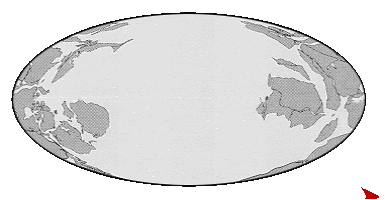CERES is the acronym for the rather chewy title Cloud Earth Radiative Effect Satellites. Displayed above is the TOA net flux in blue. The net TOA cloud radiative effect is in red. The axes are inverted to maintain the energy lost/cools planet energy retained/warms planet format. The 2005 aberration is alive and well.
There is a tension here because the All Sky net data already includes cloud effects, yet the two data series are working in opposite directions for the planetary energy balance. How can the all sky (including clouds) net flux, defined as incoming minus outgoing, be increasing; when the cloud only (net CRE) effect is pushing a roughly equal net amount of energy to space?
We can deconstruct the net CRE signal into its LW and SW components above. This makes no sense at all. Both the LW and SW components are trending towards less radiation to space, but the net effect in the first graphic is clearly towards more radiation to space.
When net CRE is compared with LW CRE above, it can be seen that they are opposing.
When net CRE is compared with SW CRE, there is far better accordance, but the trends are opposing. It might be noted that the SW trend is so miniscule as to be arguably no trend at all, but we stick with the data.
You may recall that solar adjustment improved the agreement between the planetary (not CRE) net TOA flux and the component LW and SW fluxes. So it is with the CRE net flux above. Basically, they are removing the solar aspect from the component fluxes. That’s ok, but it would be better to be more explicit.
Are clouds warming or cooling the planet?
If we look at the component fluxes, which are stripped of solar fluctuation:
LW all sky TOA flux, which includes clouds and simply measures LW photons leaving for space, has cooled the planet ~.5 W/m2 since the millennium, according to the trend.
LW CRE over the same period has warmed the planet by ~.4 W/m2.
We conclude that without the moderating effect of clouds, LW TOA flux would have cooled the planet by .9 W/m2. Bear in mind that clear sky LW TOA flux, which shows little trend, radiates to space 18 W/m2 more than all sky with clouds.
SW all sky TOA flux, which includes reflection from clouds and measures SW photons leaving to space, has warmed the planet ~1.3 W/m2 over the period, according to the trend.
SW CRE over the same period has warmed the planet by maybe .1 W/m2.
We conclude that absent solar fluctuation, reduced SW TOA flux is warming the planet, but little of the warming comes from clouds. Something else is increasingly absorbing SW radiation.
The net of LW and SW all sky TOA fluxes without solar fluctuation is to warm the planet ~1.3 W/m2. When the sun is included in the net TOA all sky flux, the warming is reduced to about .5 W/m2.
Now we are ready to see what the MODTRAN radiative transfer program predicts about clouds in the next post.











